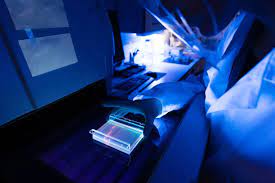In the realm of advanced technologies, UV curing systems stand as a beacon of innovation, transforming the landscape of various industries. From manufacturing to printing and healthcare, UV curing systems have become indispensable for their efficiency, precision, and eco-friendly attributes. In this comprehensive blog, we’ll delve into the fascinating world of UV curing systems, exploring their principles, applications, and the profound impact they have on diverse sectors.
Understanding UV Curing:
The Science Behind UV Curing:
UV curing is a photochemical process that utilizes ultraviolet (UV) light to initiate a chemical reaction in a light-sensitive material, leading to the quick curing or hardening of the material. The key component in this process is the UV curing system, which emits UV light at specific wavelengths to activate the curing process.
Components of UV Curing Systems:
- UV Light Source: Mercury vapor lamps, LED arrays, or other specialized UV lamps serve as the light sources in UV curing systems.
- Reflector: Reflectors are used to direct and focus the UV light onto the target material, ensuring even curing.
- Cooling System: UV lamps generate heat during operation, and a cooling system is essential to maintain optimal temperatures for consistent performance.
- Control System: Sophisticated control systems regulate factors such as intensity, exposure time, and wavelength to ensure precise curing.
Applications of UV Curing Systems:
Printing and Graphics:
UV curing has revolutionized the printing industry. UV-cured inks and coatings dry instantly, allowing for high-speed printing without the need for drying time. This results in vibrant, durable prints on various materials, including paper, plastic, and metal.
Electronics Manufacturing:
In electronics assembly, UV curing systems are used to cure adhesives, coatings, and encapsulants. This process ensures the fast and reliable bonding of components while minimizing the risk of heat damage.
Medical Devices:
UV curing finds applications in the production of medical devices such as catheters, syringes, and dental materials. The rapid curing capability contributes to efficient manufacturing processes and the production of high-quality medical products.
Wood Coatings and Finishes:
Woodworking industries utilize UV curing systems for coatings and finishes on wooden surfaces. The instant curing process enhances productivity, reduces production time, and results in durable, scratch-resistant finishes.
Automotive:
UV curing is employed in automotive manufacturing for coating applications. This process provides a glossy, resilient finish to automotive parts and ensures rapid production cycles.
Advantages of UV Curing Systems:
- Speed and Efficiency: UV curing is exceptionally fast, reducing production times and increasing throughput.
- Energy Efficiency: UV curing systems consume less energy compared to traditional curing methods, contributing to environmental sustainability.
- High-Quality Results: The instant curing process results in high-quality, durable finishes with excellent adhesion.
- Versatility: UV curing can be applied to various materials, making it suitable for a wide range of industries and applications.
- Eco-Friendly: UV curing systems typically produce minimal or no volatile organic compounds (VOCs), making them environmentally friendly.
Challenges and Considerations:
While UV curing systems offer numerous advantages, there are considerations to be aware of, including the potential hazards of UV light exposure. Proper safety measures, including the use of protective equipment and adherence to safety guidelines, are crucial to mitigate these risks.
Future Trends in UV Curing:
As technology advances, UV curing systems continue to evolve. The industry is witnessing trends such as the adoption of UV LED technology, which offers enhanced energy efficiency, longer life, and precise curing capabilities. Additionally, there is ongoing research into expanding the range of materials compatible with UV curing processes.
